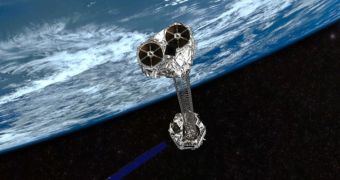Engineers at the Vandenberg Air Force Base (VAFB), in California, are currently working around the clock to install the NASA Nuclear Spectroscopic Telescope Array (NuSTAR) inside its nose cone fairing, the topmost segment of a carrier rocket.
The mission is scheduled to be launched to space aboard a Pegasus rocket built by Virginia-based Orbital Sciences Corporation (OSC). The delivery system will not take off from a launch pad. Instead, the OSC L-1011 Stargazer aircraft will take it high in the atmosphere, and then release it.
The airplane will take off from Kwajalein Atoll in the Marshall Islands no earlier than June 13, NuSTAR mission managers at the NASA Jet Propulsion Laboratory (JPL), in Pasadena, California, announce. The Lab is managed by Caltech for the NASA Science Mission Directorate.
VAFB ground crew are currently completing final pre-launch preparations on the spacecraft and the Pegasus payload fairing. They need to finish in time to attach the rocket to Stargazer by June 2, and have the plane fly to the Marshal Islands on June 5. Arrival is scheduled for June 6.
If everything goes according to plan, the spacecraft will be launched to space at 11:30 am EDT (1530 GMT), on June 13. OSC experts say that a launch simulation has already been conducted using the aircraft, and add that all systems operated within expected parameters.
After launch, NuSTAR is expected to operate in Earth's orbit for 2 years, during which the telescope will conduct nuclear spectroscopy investigations of high-energy X-ray sources in the 5-to-80 kiloelectronvolt (keV) energy range.
The satellite will orbit the planet at an altitude of around 550 kilometers (about 342 miles). Some of its preferred targets will be supermassive and stellar-size black holes, merging neutron stars, exploding stars, and other similar events. The solar atmosphere will also be investigated in detail.
This is the first space-based X-ray observatory that can be focused on specific targets. Experts expect to get images at least 10 times clearer than possible with current spacecraft. This will enable astronomers to study and determine the speed at which black holes spin, something that is not known today.
After these measurements are conducted, scientists will be able to refine their understanding of high-energy, X-ray sources in the Universe, which will in turn enable them to gain more insight into how the Universe developed. The data may also confirm or infirm existing cosmological models.

 14 DAY TRIAL //
14 DAY TRIAL //